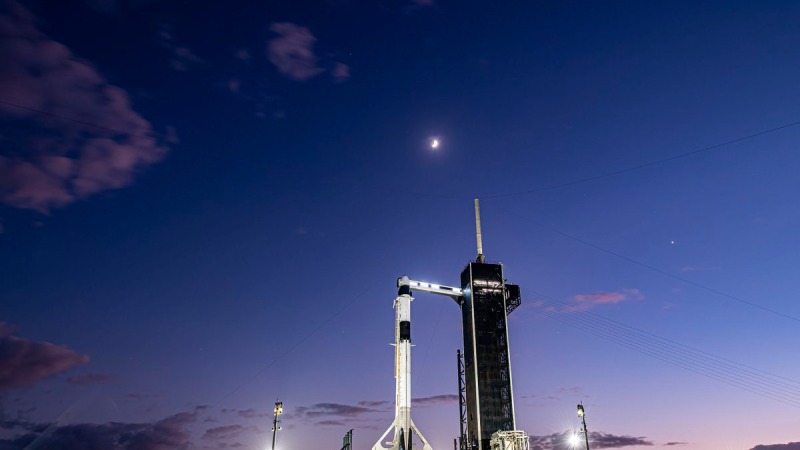The moon, Venus, Jupiter and Saturn photobombed SpaceX's Crew-3 rocket and it's just stunning
The stunning nighttime photo came on the eve of a Nov. 10 launch.
As the next Crew Dragon spaceship prepares to leave Earth, SpaceX shared a photo of the spacecraft beneath some of the other worlds of our solar system.
In the photo, which SpaceX shared Tuesday (Nov. 9), the company's Crew Dragon Endurance and its Falcon 9 rocket shines in spotlights as the bright moon, Venus, Jupiter and Saturn shine above its launch pad at NASA's Kennedy Space Center in Florida.
Liftoff is set for tonight (Nov. 10) at 9:03 p.m. EST (0203 GMT). You can watch the launch live here and on the Space.com homepage, courtesy of NASA, or directly via the space agency.
"Jupiter, Saturn, the Moon, and Venus above Falcon and Dragon tonight," SpaceX wrote on Twitter.
Live Updates: SpaceX's Crew-3 astronaut mission's launch day
The picture shows several celestial destinations shining above the rocket. "Jupiter, Saturn, the moon, and Venus above Falcon and Dragon tonight," SpaceX said in the caption. (Incidentally, Pad 39A used to host moonbound missions of Saturn V rockets during the crewed Apollo program, between 1968 and 1972.)
Not visible in the picture is Mars, where founder Elon Musk hopes one day to found a settlement; that said, the Red Planet did rise into view early this morning.
Breaking space news, the latest updates on rocket launches, skywatching events and more!
If you're looking for a telescope of binoculars to see planets in the sky, check our guide for the best binoculars deals and the best telescope deals now. If you need equipment, consider our best cameras for astrophotography and best lenses for astrophotography to make sure you're ready for the next stargazing sight.
Jupiter, Saturn, the Moon, and Venus above Falcon and Dragon tonight pic.twitter.com/S76YV1XTV2November 10, 2021
Most of the worlds in our neighborhood lie on the ecliptic of the solar system, which means that from time to time you can see several planets (along with the moon or the sun) in the sky at the same time. November has been rich in such opportunities, with the moon passing close by several worlds.
Having all these worlds along the ecliptic means that from time to time, they also line up from Earth's perspective. In fact, the moon will go into a partial lunar eclipse Nov. 19 when it passes into our planet's shadow. That eclipse will also be visible from KSC.
By then, though, SpaceX hopes to finally send Crew-3 into space after weather and an undisclosed minor medical issue delayed the launch by a few weeks. The mission will send NASA astronauts Raja Chari, Kayla Barron and Thomas Marshburn, and the European Space Agency's (ESA) Matthias Maurer, for a six-month orbital mission. Maurer will been designated the 600th person in space.
The previous human SpaceX mission, Crew-2, splashed down off the Florida coast late Monday (Nov. 8). SpaceX just began running human missions into space in 2020, after a nine-year gap in American-soil space launches following the retirement of the space shuttle program in 2011.
Follow Elizabeth Howell on Twitter @howellspace. Follow us on Twitter @Spacedotcom and on Facebook.

Elizabeth Howell (she/her), Ph.D., was a staff writer in the spaceflight channel between 2022 and 2024 specializing in Canadian space news. She was contributing writer for Space.com for 10 years from 2012 to 2024. Elizabeth's reporting includes multiple exclusives with the White House, leading world coverage about a lost-and-found space tomato on the International Space Station, witnessing five human spaceflight launches on two continents, flying parabolic, working inside a spacesuit, and participating in a simulated Mars mission. Her latest book, "Why Am I Taller?" (ECW Press, 2022) is co-written with astronaut Dave Williams.


